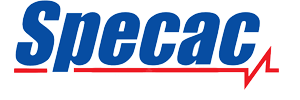IR liquid transmission cells can be used to analyze aggressive liquid samples that are acidic by nature. To meet the terms of certain Pharmacopeia regulations, IR spectral data needs to be collected in the frequency range of 4000cm-1 to 400cm-1 for chemicals and samples.
This condition may restrict the type of liquid transmission cell that can be used as the optical materials for chemical compatibility with the liquid sample because the sample itself may not deliver the transmission frequency range required for the study.
Since water based samples absorb IR radiation, the presence of excess amount of water solvent may require construction of short pathlengths cells of 6 or 12µm to obtain sufficient spectral data for transmission liquid cell measurements. The Attenuated Total Reflectance (ATR) method is an alternative technique for spectral collection of liquid samples.
ATR Technique
The ATR technique involves exposing the ATR crystal material to a liquid or solid sample for internal reflection. The quantifiable light from the sample crystal interface gives rise to a spectrum being acquired for the sample from a specific penetration depth into the sample material itself. The ATR study of liquid samples is much easier approach of sample handling when compared to a conventional liquid transmission cell assembly.
Since ATR is a reflection method, measurement of the liquid sample occurs at the surface only to a depth of a few microns instead of a bulk measurement of 10’s to 100’s microns of pathlength in a transmission cell. The selection of ATR crystal is based on the chemical compatibility of the crystal material with the sample in order to collect the optimum IR spectral data.
The Specac Quest ATR accessory
The Specac Quest ATR accessory provides the option of a germanium, ZnSe, or diamond ATR crystal pucks to be utilized on a dedicated optical unit with mirrored reflectance optical components only. This optical combination facilitates achieving the full transmission spectral range capability of the selected ATR crystal. The use of the diamond ATR crystal puck option for sampling enables analyzing a variety of liquid samples with reduced risk of chemical damage to the ATR crystal material.
Instrumentation and Experimental Procedure
This analysis involved the use of the Quest ATR Accessory P/N GS10801-B equipped with the single reflection diamond extended range ATR crystal puck option on the black surface colored optical unit to study three acid samples. The standard room temperature detector system was used to collect the spectra on a Thermo Nicolet IS5 instrument at 4 cm-1 resolution for 16 scans.
For the ATR spectral measurement, the sample was prepared by taking a small amount of each sample ‘as is’ and spotting them over the diamond ATR crystal of the Quest ATR puck option. The IR spectrum was collected immediately after initial spotting into place. The measurement was repeated three times for each acid sample to acquire a consistent set of results.
After collecting and storing the spectral data, the sample was removed from the puck immediately through washing to lower the sample contact time with the diamond ATR puck. Cleaning between these sample types was done by removing the diamond crystal puck from the Quest ATR optical unit and washing it under a cold running water supply. A tissue moistened with methanol was then used to clean the puck, followed by a dry tissue cleaning. The puck is now ready to measure the next sample.
Experimental Results
Figures 1, 2, 3 depict the IR spectra acquired for the three aggressive liquid samples. It took two minutes in total for each sample measurement. No damage is observed to the diamond crystal, surrounding stainless steel surface area, or indium sealing in the subsequent analysis of the top plate using a 10X magnification microscope. The spectra acquired for each sample are consistent for repeated measurements under the same conditions.
.jpg)
Figure 1. Acetic Acid 100% on diamond crystal puck of Quest ATR Accessory
.jpg)
Figure 2. Nitric Acid 60% on diamond crystal puck of Quest ATR Accessory
.jpg)
Figure 3. Orthophosphoric Acid 85% on diamond puck of Quest ATR Accessory
Conclusion
The results clearly demonstrate the ability of the Quest diamond ATR accessory to handle and measure aggressive liquid samples for the acquisition of their IR ATR spectra, provided the sample testing time is kept to a minimum for sample contact to the diamond crystal and puck area. The Quest ATR Accessory with the diamond puck option is suitable for the short term analysis of aggressive liquid sample types at static, room temperature and pressure conditions. The diamond crystal will remain unaffected, and the combination of the diamond crystal puck and the optical design of the Quest ATR Accessory enables studying the spectral region of 4000cm-1 to 400cm-1.

This information has been sourced, reviewed and adapted from materials provided by Specac.
For more information on this source, please visit Specac.